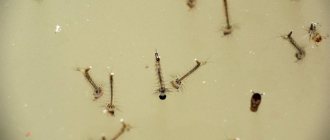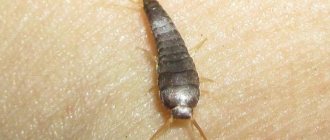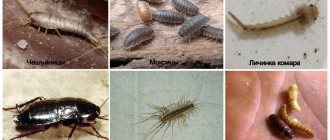Our home is a place where a person spends the main part of the day, when he wants special comfort and relaxation. Various factors can influence the appearance of insects in a human home.
That is why the appearance of uninvited “guests” can bring a lot of trouble. Particularly often insects infect two places in the apartment - the kitchen and the bathroom. The appearance of such living creatures often causes negative emotions and disgust in people; often these pests can be carriers of various infections.
The main difficulty in dealing with such pests is the fact that these insects are for the most part omnivores, which is why they are only happy to live with people under the same roof, where there is a huge amount of food.
Strange white creatures in the apartment
It would seem strange to see extra living creatures in the bathroom, since this part should always be clean, but for some, a large amount of water and a comfortable temperature play a major role.
White is a characteristic color for silverfish that have just molted. Usually these insects are up to 1 cm, they have an elongated body, silver or almost transparent color. Very be moving around.
Another species is woodlice. Not dangerous to human life and health.
Let's celebrate! Basically, these two species settle in the walls of the bathtub, since all the conditions for a comfortable life are provided for them. Unlike Prussians and other pests, they are not dangerous, do not carry disease, and do not bite.
Small white insects
This description characterizes woodlice. Such an inhabitant is not uncommon and can often be found in the vicinity of the bath. They have a light body, oblong shape with small scales. Woodlice move very quickly, so they are often very difficult to catch and even see.
Long white insects
Silverfish have a long white body. The main difference from other insects is the presence of a large number of legs on both sides.
Most are silver-black, some are brown. The main food for these insects is glue. In addition to typical inhabitants, the bathroom can be subject to attacks by cockroaches, midges and ants.
Where does the attack come from?
There are basically two objective reasons for the appearance of “tenants”:
- various types of communications - woodlice, millipedes, etc. migrate with impunity through ventilation shafts;
- interruptions in the operation of filtration systems, for example, in the tap water there may be small black worms in the bathroom - mosquito larvae.
We create the remaining prerequisites ourselves in pursuit of glamorous design or due to banal laziness, they can be:
- warm water pipes hidden in boxes under the casing; but small-timers will always find a micro-crack to squeeze through to visit you;
- condensation flowing into nooks and crannies under the bathtub that are difficult to reach;
Pandemonium in a wet corner
- damp rugs on the floor near the bathroom/toilet;
- dust;
- clogged drains;
- storage area for rags under the bathroom.
Why do small white insects appear in the bathroom?
The most important question that arises among residents of apartments is where insects have appeared, where and how they came from.
To begin with, we should highlight the main factors that attract uninvited “guests” to the house. The maximum level of humidity is comfortable for such bugs; it is in it that insects can lead a normal life, they have a habitat, food and the opportunity to reproduce. They always have plenty of water and food nearby.
A person spends a minimum of time in the bathroom, which means that extraneous sounds will practically not frighten the little inhabitants. Since this room is the least visited, it means that it is almost always dark, this is another important factor for such insects.
All these factors make it clear that the bathroom is a great place to live.
Having figured out what attracts bugs to a human home, it is important to understand where and how their appearance can be provoked:
- Open basements and ventilation compartments, presence of insects among neighbors. This is how bugs often immigrate. The easiest way for them to penetrate is to the first and last floors.
- Failure to keep the room clean.
- High humidity.
- Relatively high air temperature.
Let's celebrate! To avoid the appearance of such pests, it is recommended to carefully maintain the cleanliness of the bathroom.
Measures to “clean up” the territory
Constantly scrubbing a bathroom down to the last square millimeter is difficult, but it is possible to apply basic preventive measures . Instructions for keeping dry are as follows:
- reduce humidity - eliminate leaking taps, ensure good ventilation;
- cover the ventilation holes with fine mesh;
- seal cracks in walls, floors, and ceilings;
- use floor mats made of special materials - rubber, silicone, fiber polymers, bamboo;
- do not create deposits of dirty laundry;
- wipe surfaces weekly with chlorine-containing preparations;
- After general cleaning, thoroughly dry the room using a fan or household dehumidifier.
Desiccant with tablets
By using replaceable absorbent tablets/granules, you will save electricity. One tablet weighing 450 g is enough for a year.
Chemicals
After eliminating the causes of dampness, insecticides will become powerful means of exterminating pests in the bathroom.:
A guaranteed result is provided by professional disinfestation of the premises performed by special services, no matter what its price.
Several types of processing are used:
- cold fog;
- barrier protection;
- hot fog;
- complex.
Are white insects dangerous and harmful to humans?
- Silverfish are not harmful to humans; they do not harm domestic animals.
- These insects do not bite because they are small in size and have an unsuitable mouth for this.
- Such “residents” can cause a negative reaction in people, as they appear unexpectedly and can frighten or disgust.
- Despite their safety for humans, such creatures are still not pleasant, as they can cause damage to property. Being mostly omnivores, they can spoil food, cereals, sugar, even wallpaper and books, as well as leather products.
Fight against hay beetles and mold
Dealing with hay beetles is quite easy - it is enough to carry out one or two treatments with contact insecticidal preparations within the infected apartment. The best results are obtained by treatment with cold or hot steam (“hot fog”). This method gets rid of small insects instantly and for sure. At the same time, the proximity to cockroaches, bedbugs, and fleas, if any, is eliminated.
In parallel with insecticide treatment, it is advisable to disinfect the premises from mold, which these insects feed on. A humid environment is always a provoking factor for the occurrence of mold. Hay eaters are not the worst thing to be afraid of, although such a neighborhood is quite unpleasant for a person. The mold next to them is much worse. Mold fungi can affect humans and lead to intractable chronic diseases. Fungicidal preparations are used for disinfection. Hot fog is used against mold. When using this method, the smallest particles of the solution get into the most inaccessible places - under wallpaper, into cracks in the joints of walls and ceilings, peeling plaster, etc.
All shortcomings made during construction must be eliminated by the management company. Repairing cracks in wall joints, repairing roofs and basements, and eliminating leaks is the responsibility of the management company.
Be sure to take measures to dry the premises.
How to dry an apartment after renovation
In winter, drying is not a particular problem - just turn on the central heating radiators. In summer, it is necessary to use heat guns. Do not forget about regular ventilation of the apartment. It is ideal if special ventilation valves are installed under the windows and the hood is functioning. If the humidity remains high, then you need to check the serviceability of the plumbing and pipes. If the plumbing was installed improperly, then there may be hidden faults in the plumbing equipment, then moisture will leak unnoticed, gradually accumulating in wall voids, under the bathtub and other hard-to-reach places.
How to get rid of insects in the bathroom?
Physical methods
First, you should carry out a complete sanitary cleaning of the apartment, since it makes no sense to poison pests in a contaminated room and will not lead to positive consequences.
First of all, people try to fight such insects manually, in the hope that due to their small size they will be easy to eliminate:
- One of the main tools is a vacuum cleaner. With its help, people carry out general cleaning, trying to suck in the main habitats. This method is very labor-intensive, since it is impossible to kill one insect at a time, and using a vacuum cleaner does not provide a 100% guarantee. As a result of such treatment, you can easily miss a place with pests, and then this whole idea goes in vain. Even if you managed to remove some nests with a vacuum cleaner, this does not mean that there are no others left.
- Another method is treatment with boiling water. Cleaning is also carried out and boiling water is poured onto the nests and holes. This causes the insects to flee to another location. This method also does not guarantee anything, since pests can easily escape to another secluded place in the apartment.
- All living beings do not like cold. This leads to the next method - to lower the temperature in the room as much as possible.
Let's celebrate! These methods are very simple, but do not guarantee that the person has removed all the insects and that they will not return after a while.
Traps and bait
- Traps include the use of traditional methods. It is recommended to place wreaths of birch branches in the corners of the bathroom overnight. Bugs remain in the rods overnight. Such a wreath must be thrown away immediately, or better yet, burned.
- For the next trap, use a glass jar. Place paper or tape on the outside. Any sweet product, such as an apple or sugar, is placed inside the jar. The silverfish easily climbs up the jar, penetrates it, but cannot get back out. The next morning they get rid of insects in such jars.
- Another bait is a roll of paper. You need to moisten it overnight and leave it on. Insects cannot live without moisture, so they will not ignore such a roll. During the night, many pests crawl into such a “house”. In the morning, it is important to throw away such a roll, or burn it without unrolling it.
Chemicals
The most effective in fighting insects are chemicals; thanks to them, it is possible to get rid of pests for a while, along with their larvae.
There are a large number of drugs on the market today aimed at controlling household pests.
Copper and iron sulfate, as well as products containing chlorine, are considered the most effective. Among the assortment you can find sprays, aerosols, powders, gels and other types.
Some of the most popular and effective aerosols include the following:
- Raptor;
- Mosquitall;
- Combat;
- Antimol;
- Dichlorvos;
- Raid;
- Clean house;
- Armol;
- Extramit.
These preparations are suitable for long-term treatment; at first it is recommended to spray them indoors once a week.
When working with such drugs, it is important to follow the instructions, since such products have a pungent odor that negatively affects the human respiratory system.
Let's celebrate! Therefore, when using chemicals, it is advisable to use protective clothing, remove animals and children from the apartment during treatment, and ventilate the room.
Traditional methods
Folk remedies have been around for a long time; they are particularly effective, low cost and simple.
Such methods have existed for more than 100 years, so there is no point in doubting their effectiveness:
- Regular sugar, as well as brown sugar, can be considered the main assistant. It is distributed into cracks and places where white bugs may appear.
- Yeast can be decomposed in the same way. Such living creatures do not like the smell of cloves, so it is necessary to sprinkle this particular spice indoors.
- You can also treat all surfaces with water with the addition of citrus or lavender oil.
- The next assistant is boric acid. This product helps fight a large number of household pests. Balls should be made from a boiled egg and boric acid powder and placed in the habitats of living creatures.
The appearance of any harmful living creatures in an apartment is due to non-compliance with hygiene rules, both on the part of the owners and neighbors. When such a problem appears, it is important to solve it immediately, without delaying it, since then the insects will multiply and it will be much more difficult to remove them.
First of all, you need to find the source of the problem, if insects are fleeing from the basement, then block all kinds of entrances and exits for them; if the problem is with the neighbors, then you may have to deal with them, you may have to poison them not only in your apartment, but also in the neighboring one.
In any case, there is no need to panic and be afraid of these insects, because fear and panic will not help in any way in the fight against pests, thereby a person will only waste time.
Types of silverfish: what “enemy” you have to deal with
Silverfish in an apartment is the result of unsanitary conditions
Appearance of “lovers” of humid climates
The insect's body length can reach 1.9 cm, it is flat, tapering from head to tail. The silverfish got its name from the silvery scales with which it is covered. From the head, two whiskers are directed forward, three similar tails are directed behind, there are no wings. The eyes are compounded, with color vision that perceives ultraviolet light.
The common silverfish, or as it is also called, the sugar fish, moves very quickly along the floor, ceiling, can run into a narrow crack, hide in a hole, and all this with the help of three pairs of legs with tenacious claws. Such organs of movement make it difficult to fight insects, since seeing does not mean catching, and they hide perfectly.
If you look closely, you can catch the resemblance to a fish fry, for which the British call it silverfish. Scientists have counted almost 600 species of silverfish in nature, 10 of which live in Russia. But only two apartments are besieged by silverfish and house thermobia.
Places of deployment and diet
Knowing the “habits” of insects makes it easier to find and destroy them. Most of all, they like to hide in damp places, where they can profit from something. They eat quite a varied diet. Paper, wallpaper, books, bulk products (flour, pasta, cereals), animal feed, cotton and silk items are used. The most unpleasant thing is that the lack of food does not frighten them; in favorable living conditions, they can live for about a year without food at all, and with good nutrition they can live for five years.
Determining whether there is a silverfish in an apartment or not is sometimes difficult, since the insect prefers a nocturnal lifestyle. First of all, where it can be found - places with humid air, condensation, water. These are bathrooms, toilets, shower boxes, and other places that are often closed during renovation, creating an aesthetic appearance - sewer pipes and cold water pipes located in hard-to-reach places, for example, under the bathtub.
Important! Silverfish insects that come into your home are not carriers of diseases, they do not bite, but you must fight them!
What to do when moth larvae appear?
If moth larvae appear in the kitchen, it means that the insects are already actively breeding and their number will increase more and more quickly. Therefore, if you find white worms in your apartment, you need to take action as soon as possible.
First of all, a thorough audit of bulk products, pasta, cookies, and nuts will be required. At the slightest suspicion that they may be infected with parasites (the seal of the packaging is broken, garbage or moth eggs are visible), the products should be thrown away.
Kitchen cleaning
Next, you will need a general cleaning of the kitchen with washing the floors, all cabinets and shelves (outside, and especially inside), ceiling and walls. It is also necessary to wash the dishes in which spoiled food was stored.
After this, you can proceed directly to the destruction of insects.
The main types of pairs of antennae in insects
The main tactile and olfactory organs of insects are paired articulated antennae (or antennae) movably attached, usually on the forehead, between the eyes, in special articular pits covered with a membrane. The length and shape of antennae in insects is extremely diverse and often serves as a visual indicator for identifying families, genera, and species of insects. The number of segments in the antennae varies among different insects from three to a hundred or more. In the general structure of the antennae of insects, three sections are distinguished: the manubrium is the first segment, the stalk is the second segment, and the flagellum is the totality of the remaining segments. Only the arm and leg are equipped with their own muscles and are actively mobile. Inside the leg there is a cluster of special sensitive cells - the Johnston's organ, which perceives environmental vibrations, and in some insects also sound vibrations.
Insects have numerous types of antennas. Setae-like antennae are thin, tapering towards the apex (cockroaches, grasshoppers), and filamentous antennae are thin, uniform along the entire length (ground beetles, locusts), and are also called simple due to their typical shape. The bead-shaped type of insect antennae is distinguished by convex, laterally rounded segments (darkling beetles). The segments of saw-shaped antennae have sharp corners, giving a jagged shape (click beetles and longhorned beetles). The elongated processes have segments of comb-like antennae (some species of click beetles and moths). The type of antennae of insects with the apex thickened due to the expanded last segments is called club-shaped (day butterflies). Antennae with a large, pronounced club are capitate (grave-digger beetles and bark beetles). The antennae of insects with a club consisting of wide lamellar segments are called lamellar-clubs (chafer beetles and dung beetles). The spindle-shaped antennae widen towards the middle and are narrowed and pointed at the apex (hawkmoth butterflies). The cranked antennae are bent at the articulation of the handle with the rest of the body (wasps, ants). The geniculate pairs of insect antennae ending in a club or comb are called, respectively, geniculate-clubs (weevils) and geniculate-combed (stag beetles). The segments of the feathery antennae are equipped with densely arranged thin sensitive hairs (moths, some mosquitoes). The setaceous antennae are always short, 3-segmented, with a sensitive seta (flies) extending from the last segment. Antennae with asymmetrical segments of different shapes are called irregular (blister beetles).
Summarizing
Having once experienced the shock of meeting an incomprehensible bug-worm in the bathroom, which should not be there in principle, the attitude towards cleaning this room changes radically. For some reason, small animals/insects inspire superstitious fear, probably because of their ability to suddenly disappear and hide in unexpected places. After the “reclamation” of the bathroom, the only person who can wander in there is an innocent spider – a symbol of wisdom and creativity.
More information about some of the inhabitants of the bathroom can be found in the video in this article.
In the comments to the article you have the opportunity to express your opinion or share information on the topic.
Our home is a place where a person spends the main part of the day, when he wants special comfort and relaxation. Various factors can influence the appearance of insects in a human home.
That is why the appearance of uninvited “guests” can bring a lot of trouble. Particularly often insects infect two places in the apartment - the kitchen and the bathroom. The appearance of such living creatures often causes negative emotions and disgust in people; often these pests can be carriers of various infections.
The main difficulty in dealing with such pests is the fact that these insects are for the most part omnivores, which is why they are only happy to live with people under the same roof, where there is a huge amount of food.
Silent occupation
A bathroom is a specific room with a high level of humidity, located in the dark most of the day. Such conditions are ideal for small crawling and running animals, for which everyone often creates favorable conditions with their own hands.
Dragons will soon live here
If you Google it, you will be surprised to learn that crustaceans and even animals may also be scurrying around under your feet! Let's look at the most typical bathroom troublemakers:
- silverfish are primarily wingless insects from the bristletail order;
- woodlice - a class of higher crayfish of the order of isopods;
- nods - invertebrates from the order Centipedes;
- centipedes are arthropods considered to be the closest relatives of insects;
- mosquitoes are insects from the order Diptera;
- Tubifex - class zonalis, subclass oligochaetes.
Silverfish
Small white worms in the bathroom, at first glance, turn out to be elegant insects up close - sugar silverfish up to 2 cm long, with a characteristic teardrop-shaped body and three tail processes. Not being predators by nature, they can cause significant damage to wallpaper, linen, and books (think about it, fans of newspaper racks in the bathroom).
It also feeds on mold and fungi that grow only in a humid environment, so the appearance of sugar silverfish should alert you . The insect does not hibernate, but diligently reproduces, laying about 70 eggs in June-July.
The habit of hiding in the natural environment under stones, sticks, and in the leaves of a sugar bowl is also retained in the bathroom, cleverly being buried:
- in crevices;
- under peeling paint;
- under the bathtub, basins;
- in caked underwear.
Preferring darkness, silverfish rush in different directions as soon as a bright light comes on. However, on glazed tiles their speed decreases sharply, and if they get into a puddle or even a drop of water, they stop altogether.
Kivsyaki
Living in natural conditions, mostly underground, it appears by chance in the fallen leaves in the bathroom. Thanks to their smooth body, they look like worms in the bathroom, although specimens up to several centimeters in length make them look like snakes.
Demo version of kivsyak
The body of the centipede is covered with a chitinous layer, which does not prevent it from curling up smartly in case of danger. The “worms” move quite slowly, you can simply pick them up with your hand and take them outside, especially since they process plant residues well.
Woodlice and mosquitoes
These creatures, as a rule, appear by chance - woodlice, usually rise from the basement or ventilation ducts and quickly leave if the humidity is low. If these crustaceans stubbornly refuse to leave, most likely a pipe is leaking somewhere, creating favorable conditions for their residence.
Woodlice look like miniature armadillos - they curl up into a tight ball when touched; they are gray on top (juveniles are light-colored) and have a whitish belly. May cause harm:
- indoor plants;
- to humans, because they are carriers of fungal pathogens, depriving.
Mosquitoes fly into the bathroom, mainly if there is stagnant water in some container or there is no mosquito protection on the windows. They cannot reproduce here because the larvae must develop in stagnant water.
flycatcher
What is capable of inspiring horror is this fast-moving (40 cm/sec), silent arthropod, appearing out of nowhere and smoothly “flowing around” obstacles. The abundance of long legs and the longest mustaches are frightening, which can be confused with the same long hind legs - just pull and push.
If you remain neutral, the centipede can thoroughly clean your apartment and destroy:
European scolopendra species are not poisonous, although the bite (if it is strong enough to bite through the skin) will be akin to a wasp sting. If the very thought of such a neighbor is unpleasant to you, you can, of course, use a slipper, or else you can catch it in a jar and take it out of the house.
Prevention
As practice shows, it is easier to prevent any problem than to deal with it for a long time.
There are several preventive methods, following which, a person will never know what white insects are in the bathroom:
- First of all, you need to determine the humidity in the room using a special device. If this indicator is higher than normal, then it is necessary to install additional ventilation equipment. This small step will always allow you to maintain normal conditions in the room, under which insects will not appear.
- It is recommended to clean the bathroom as often as possible , ventilate and treat all cracks with a disinfectant solution.
- You should hang a thermometer in the room for several days and measure the indicator for at least five days. Next, you need to calculate the average temperature. If it turns out to be more than 27 degrees, then you should ventilate as often as possible.
- The condition of the pipes should be constantly monitored. There should not be excessive dampness on them. If it does form, then it is worth doing forced drying;
- It is worth treating the room with chlorine at least once a month.
- It is not recommended to dry wet things in the bath.
Experienced experts also recommend replacing old pipes with double-glazed windows; in their opinion, this trick reduces the risk of various species occurring. In a word, you should carefully study the favorable environment for the existence of bugs and completely disrupt it, so that they feel uncomfortable living in it.
It should be said that for a person, this aroma, on the contrary, has a positive effect: it relaxes, invigorates and reduces depression. Compliance with all preventive measures will prevent unexpected “residents” from appearing in the house.
What are small insects? These are absolutely harmless bugs that can cause hostility in humans. Almost every fifth person in the country has encountered this problem at least once in their life.
Fortunately, there are a huge number of methods that will allow you to get rid of white bugs in the shortest possible time, using preventive measures and modern equipment. Thus, the presence of such individuals in the bathroom is not a problem in modern life.











